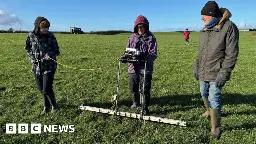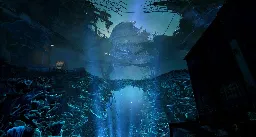
- www.theguardian.com Book returned to Cumbria school library 113 years overdue
Poetry of Byron borrowed by schoolboy Leonard Ewbank, who studied at Oxford and was killed at Ypres in 1916

cross-posted from: https://feddit.uk/post/18872255
> > A book borrowed from a school library before the first world war has finally been returned – more than a century overdue. > > > >A copy of Poetry of Byron was found by a man in Carmarthenshire, south Wales, who felt it should be returned to St Bees School, near Whitehaven, Cumbria, where it had been lent out to a schoolboy. > > > >Inside the blue clothbound book the name Leonard Ewbank is written, along with the date 25 September 1911. Ewbank, who was born in 1893, was a pupil of St Bees between 1902 and 1911, before going on to study at Queen’s College, Oxford. > > > > Records show that, despite his poor eyesight, he was recruited to the 15th Border Regiment in 1915 to fight in the first world war. He was killed in battle on 23 February 1916 by a bullet to the head and is buried at the Railway Dugouts burial ground in Ypres, Belgium, a cemetery that contains the graves of 2,463 troops. > > > > ... > > > > Ewbank is commemorated on the school’s roll of honour as “an Englishman, brave, honest and loyal”. > > > >The school was “honoured” to have the book returned, said the headteacher, Andrew Keep. Keep told the BBC: “It’s incredible to think that a piece of St Bees’ history has found its way back to us after all these years.” > > > > ... > > > > The book, featuring the work of Lord Byron, a Romantic poet famously described as “mad, bad and dangerous to know”, is not the first to be returned to a library after spending a lifetime elsewhere, but it could be one of the most overdue library books of all time. > > > > In May, a book borrowed from a library in Helsinki was returned 84 years overdue. A Finnish translation of Sir Arthur Conan Doyle’s historical novel The Refugees had been due on 26 December 1939, a month after the Soviet invasion of Finland, so it “might not have been the first thing on the borrower’s mind”, said Heini Strand, a librarian at Helsinki’s Oodi central library. > > > >In July, Canoe Building in Glass-Reinforced Plastic by Alan Byde was returned to Orkney Library more than 47 years late, after being found during a house clearance. The library’s John Peterson said: “Fortunately we don’t charge overdue fines.”
-
Beast of Cumbria: 'Big cat and cub' spotted in Cumbrian countryside
cross-posted from: https://feddit.uk/post/16154589
> > Trail cams have been set up in the Cumbria countryside following a reported sighting of a big cat and her cub. > > > > A report came into a dedicated Big Cats Facebook group that a couple spotted the feline, described as a 'large black cat', alongside her cub. > > > >The myth of the elusive 'Beast of Cumbria' is believed to have started when big cats kept as pets in the 1970s were released due to licensing changes. > > > >Big cat expert Sharon Larkin-Snowden, who discovered Panthera DNA on a sheep's carcass in Cumbria in May of this year, posted the latest sighting reported to be by a couple in the group. > > > > The post read: "Exciting news! We have had a few reports of a large black cat and her cub. Both look well and healthy. We now know her whereabouts (lair) and are setting up many trail cams in the vicinity in hope of capturing footage of mum and cub.
- www.bbc.com Archaeologists to dig for medieval wooden building on Silloth farm
One theory put forward is the potential timber structure was once a barn belonging to monks.

cross-posted from: https://feddit.uk/post/14366104
> > Volunteers are set to take part in a 12-day archaeological dig in the hope of finding signs of medieval life on a farm. > > > > The excavation at High Tarns Farm in Silloth will begin on 22 July. > > > > It will be led by archaeologist Mark Graham and follows his discovery of crop marks on the land, which suggest it was once the site of a large medieval building. > > > > Mr Graham said he was "excited" but warned it could be a let down, adding: "If you're going to be an archaeologist, you better get used to disappointment." > > > > Due to written records, archaeologists have long known that part of the town was once the site of a medieval farm linked to Cistercian monks. > > > > ... > > > > The marks looked like a "footprint of a large timber building", he said, adding: "I nearly fell off my chair." > > > > He suspected the building was timber as the marks corresponded with holes required for large wooden posts to hold up such a structure. > > > > No such building is detailed in maps going back to the 1800s, he added, and the marks suggest the building is about 50m (164ft) long and 20m (66ft) wide. > > > > Mr Graham's two main theories about the potential building are that it was once a barn belonging to the Cistercian farm, or it is even older and was the home of a Viking chieftain. > > > > "There have been houses on the scale that we're talking about excavated in Scandinavia but to find such a thing here in Cumbria would be absolutely remarkable," he said.
-
Nuclear fallout: New video game reimagines Cumbria post-Windscale disaster
> A video game inspired by the Windscale disaster is set to be released next year. > > Atomfall is a survival-action game with horror elements based in a post-nuclear apocalypse version of Cumbria and the Lake District. > > Players will be able to explore a dark version of the county’s countryside and interact with cults, rouge government agencies, a military beset with factions and other unusual characters along the way. > > West Cumbrian landmarks including Sellafield and the site’s old golf ball building and cooling towers, also make an appearance in Atomfall. > > The Fallout-esque game was announced yesterday evening at the Xbox summer showcase and is being developed by Rebellion, best known for the Sniper Elite franchise. > > Inspired by the real events of the 1957 Windscale disaster – the game takes place five years after the fire, in a fictionalised quarantine zone.
